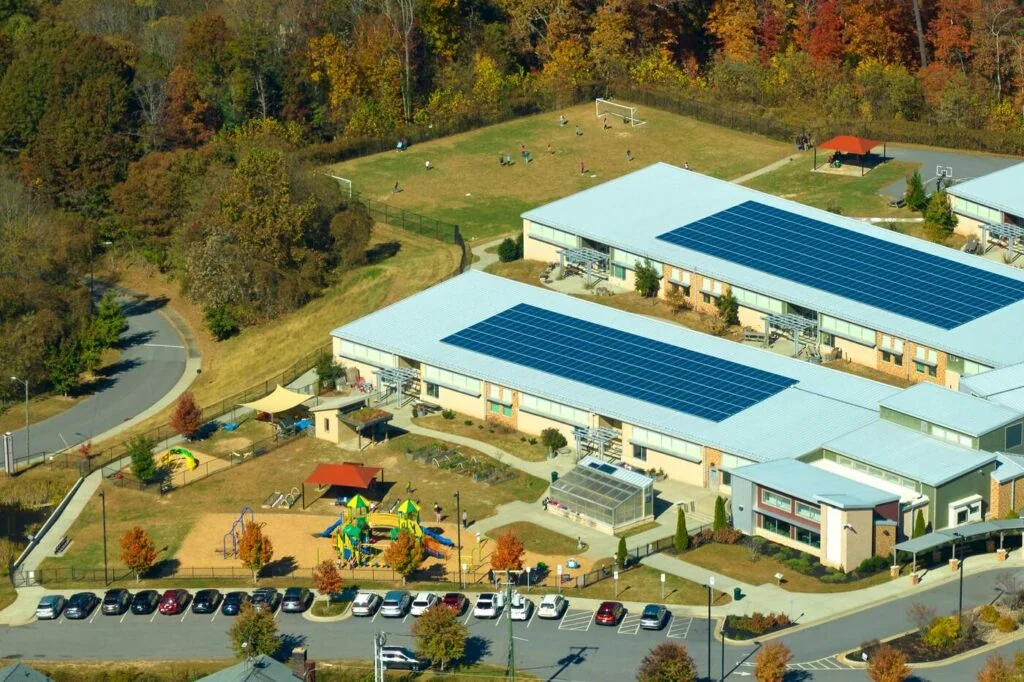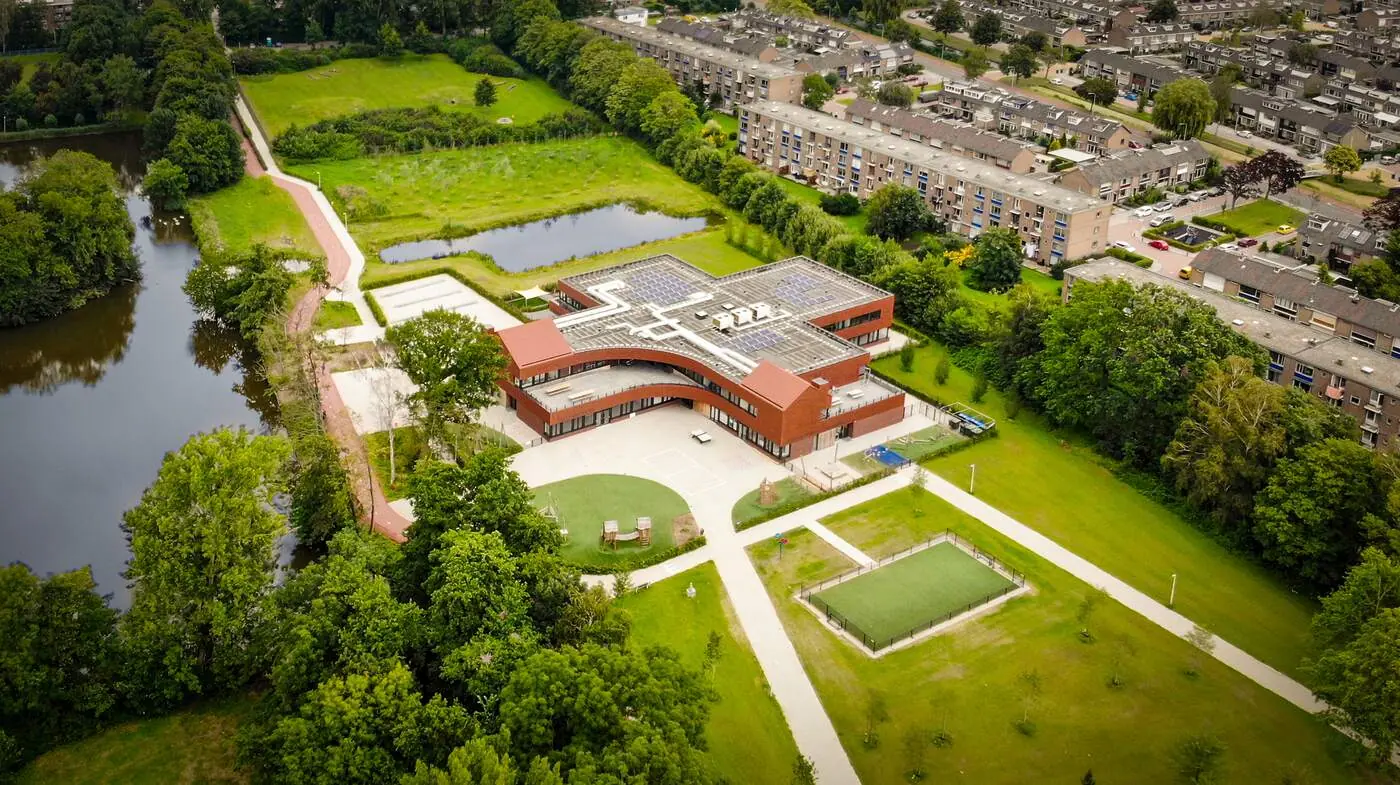Our schools and educational facilities are all about building brighter futures for our children, students, and mankind. For this reason, the last thing that the administration, student body, and other education building occupants should have to think about is the roof over their heads. But someone has to.
To help, we put together this guide on the need-to-knows about roofs for schools and educational facilities. We’ll cover the most important details, including budgets and budget options as well as navigating the process. Keep reading to learn more about the ABCs of roofing for schools and educational facilities.
School Roof Types
There are several types of roofs used to protect schools, colleges, and other educational facilities. These “types” refer to the structure and architectural style of the roof and it’s important to understand each style and their pros and cons.
Flat Roofs
Low slope or “flat” roofs are characterized by their almost unnoticeable slope. They’re the most common roofing types for large buildings.
Advantages
- They have plenty of space for green roofs, HVAC units, and other uses.
- They’re less expensive to build on large structures.
- Easier access for maintenance and repairs compared to steeply pitched roofs.
Disadvantages
- Proper drainage is critical to prevent water pooling, which can lead to leaks and structural damage over time.
- Flat roofs may require more frequent inspections and maintenance due to potential drainage issues and exposure to weather elements.
Pitched or Sloped Roofs
Pitched roofs are the most traditional roofing type used on residential buildings and small schools. Picture a quaint, one-room schoolhouse and you’ll envision a pitched roof by default. They’re excellent for shedding rain and snow, and they can provide some storage overhead.
Advantages
- The steep slope roofs allow water and snow to run off quickly, preventing leaks
- Overhead space allows for better ventilation and storage
- Provide the traditional schoolhouse look
Disadvantages
- There may be less space for equipment than on a flat roof roof
- They’re more dangerous to scale and repair due to their slope
- They’re extremely expensive to build over a large building
Hip Roofs
A hip roof is a roof with a slope on three or more sides that meet at the ridge in the middle. They’re common in southern states where roofs need to be able to handle high winds.
Advantages
- Hip roofs are very stable and capable of resisting wind better than pitched roofs.
- They provide symmetrical appeal to improve the look of the building.
- They shed water and snow easily, preventing leaks.
Disadvantages
- They’re typically more expensive to build than a pitched roof
- They share the same limitations as pitched roofs (limited space for mechanical equipment)

Roofing Materials for Schools
As with any structure, several types of roofing materials can be used on a school or educational building. These are typically the same materials that one could find on a commercial, industrial, or medical building,
Asphalt Shingles
Asphalt shingles are a great option for sloped and hip roofs. Asphalt shingles are affordable and relatively easy to install and can provide 25 years or more of protection against the elements. However, due to their layered nature, they’re not suitable for flat or low-slope roofs.
Metal Roofing
Metal roofing is extremely durable and will last for decades. There are even variations that can be installed on low-slope roofs. Metal roofs are generally very expensive, but their longevity often pays for itself and the peace of mind they provide is unbeatable. They may be a great option for schools, budget-allowing.
EPDM Roofing
Ethylene propylene diene monomer is a single-ply roofing system that installs quickly on flat and low-slope roofs. It’s tough, has a long lifespan, and it’s relatively inexpensive. It’s also resistant to UV rays and can be patched easily.
TPO or PVC Roofing
Thermoplastic olefin or polyvinyl chloride membranes offer great options for flat and low-slope school roofs. It reflects heat, improving energy efficiency, and it’s resistant to UV rays. Since it’s a single-ply system, it’s easy to install and maintain, similar to EPDM.
Know Where to Start
You need to know where to start when planning an educational building roof replacement. Understanding the building’s and its occupants’ needs is important. An engineer, architect, or roofing expert can help folks work their way through the following considerations.
Safety and Durability
The roofing protecting an educational facility has to be safe and durable. Children spend many hours inside these buildings each week, as do the teachers, support staff, and administration. The building protects them from heat, high winds, heavy snow, thunderstorms, and more. When choosing a roofing material, it has to be capable of withstanding the elements.
Energy Efficiency
One of the best ways to improve a building’s energy efficiency is to add insulation and cover it with an energy-efficient material. Some roofing materials, like PVC and TPO, can reflect heat energy, keeping the building from spending too much on cooling costs.
Budget Constraints
Depending on the building and institution, budgets can be a big concern. Public schools paid for by taxes need to meet the budget approved by taxpayers. Private institutions need to meet the requirements set by the board of directors or facility owners.
And it’s not just the purchase and installation that needs considering. Long-term maintenance should also be considered, as a cheap roof now can be expensive down the road—especially if it’s not installed by a knowledgeable crew of experts.
Seasonal Planning
Education is one of the only industries that has a clear “best” season for renovations like roofing projects. While summers are difficult for the roofing crew, it’s the best time of year to prevent disruption to the campus. Deliveries are easier to handle and most projects can be completed well before students return the following year. Also, the lengthy breaks that occur throughout a school year are great opportunities for small to medium-sized projects.
The Installation Process
Installation is obviously one of the most critical aspects of installing roofs on school buildings and educational facilities. The best materials in the world won’t last if they’re not installed properly by a crew that knows what it’s doing.
Hiring Qualified Contractors
It’s important to hire qualified contractors who know what they’re doing. They should have a history of installing a wide range of materials on top of several types of buildings. They should also have an extensive safety history, carry any required licenses, and provide copies of insurance and other required compliance documents.
Compliance with Local Building Codes
Any roofing material and crew chosen need to meet local building codes, as does the installation process. Typically, the contractor will meet with the local inspector, provide copies of insurance and licenses, discuss the materials and process, and secure the required permits. The contractor should also organize subsequent inspections throughout and after the installation process.
Safety Measures
When it comes to educational facilities, safety is of the utmost importance. The safe storage of materials, roof access, roof edge safety, and any necessary PPE should be prioritized to ensure that everyone is safe—both crew and building occupants—during the removal and installation process.
Removal
In some cases, the existing roof will need to be removed from the facility before the new one can be installed. This isn’t typically a long process but does need to be accounted for in terms of scheduling and budgeting. The manpower required to remove the material and the disposal fees will be part of the quote and may impact which materials are chosen for the project.
Material Installation
When it comes time to install the materials, it helps to know what to expect. The following will explain the basic rundown for installation of the most popular roofing materials.
Single-Ply
For single-ply roofing materials on a flat roof, expect the crew to roll out sheets of the roofing material, overlapping their edges and bonding them together with tapes or heat welding them. Depending on the chosen method, these materials can be fastened with mechanical fasteners, adhered to the surface, or ballasted with stones.
Metal Roofing
It may be necessary to install a substructure under the metal panels, but these panels will also overlap and be fastened to the deck. The laps may be adhered or simply overlap each other. While each panel covers a lot of roof space, the process can be slow on a low-slope roof.
Shingles
Shingle roofs are relatively straightforward. Waterproofing materials are applied to the deck surface and then the individual asphalt shingles are attached directly to the deck, with each course overlapping the course below it. This is typically a fast process but does take a lot of manpower to keep the project moving on a large building.
Ongoing Maintenance
With installation over, it’s up to the building’s operations department to ensure that it’s properly maintained to ensure it lasts as long as possible. Here are some tips:
- Plan regular inspections: Be sure to walk low-slope roofs multiple times throughout the year and inspect for damage. It’s also a good idea to hire a roofing expert to inspect the roof twice a year and patch or repair any small issues.
- Perform preventive maintenance throughout the year: Keep the roof clean, address minor issues, prevent downspouts and scuppers from becoming clogged, and make calls for service on any large issues discovered.
- Hire professional preventive maintenance: Allow a team of experts to maintain and manage roofs and their warranties to get the most out of your facility’s investment.

Energy Efficiency and Environmental Considerations
Believe it or not, a roof can offer a lot in terms of energy efficiency and environmental friendliness. The following are some important considerations to work through with your contractor.
Green Roofing Options
Particularly with educational facilities, green roofs can be exciting opportunities to give back to the environment. Built on top of durable membranes, green roofs consist of grasses and other native plants, helping offset the building’s carbon production. Green roofs also offer excellent insulation, helping the building remain more comfortable throughout the year. Children and students love these features, as well.
Cool Roofs
Cool roofs increase a building’s energy efficiency by reflecting the sun’s light, reducing cooling costs and energy consumption. These roofs consist of white reflective surfaces or coatings and they’re particularly helpful for educational facilities in hot climates.
Cool roofs are designed to reflect more sunlight and absorb less heat compared to standard roofs. They are made with highly reflective materials that can significantly reduce cooling costs and improve indoor comfort. Cool roofs are particularly beneficial for schools in hot climates.
Solar Panels
Incorporating solar panels into the roofing system can further enhance the energy efficiency of the facility. Solar panels can generate electricity, reduce energy bills, and provide a renewable energy source for the school. Additionally, they offer an educational opportunity for students to learn about renewable energy and sustainability.
Common Challenges for Educational Facility Roofs
Weather-Related Damage
Schools and educational facilities are exposed to harsh weather conditions like extreme heat and cold, blizzards, torrential downpours, hurricanes, tornados, and other weather events. Speak to your contractor to ensure that the roof you choose is suitable for the local climate and can withstand the expected weather patterns. Regular maintenance and timely repairs are essential to mitigate weather-related damage.
Minimizing Disruptions
School days should be as impactful for the children as possible, but the roofing project should not. The roofing installation should minimize disruptions as much as possible to ensure that education comes first and goes according to plan. Careful planning for delivery and certain phases of the project is necessary, and the more work that the crew can perform during breaks or summer vacation, the better.
Let Nations Roof Handle Your School or Educational Facility’s Roofing Needs
Your school or education facility deserves the best from its roofing contractor. Let Nations Roof handle the job. With over 100 years of combined experience, we can handle any building or roof type’s roofing needs. We’ll help you choose the best materials for the project, increase your building’s energy efficiency, manage your maintenance and warranties, and protect your students and staff for decades to come.



